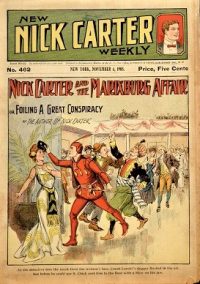
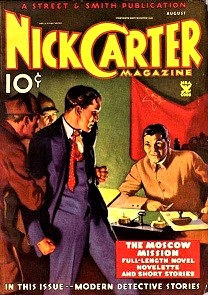 Nick Carter, Master Detective (1943-1955) originally aired “Nine Hours to Live” on January 15, 1944. However, it was rebroadcast on April 16, 1946 and it is this rebroadcast we offer here. This is the 16th Nick Carter episode we’ve run since 2009, and only the 2nd since August of 2020 (the previous episode being in February of this year). Carter’s history is long, covers numerous media, and is one of the more fascinating we’ve come upon. To crib from one of our earlier entries for new listeners, and slightly tweaked with new material, Nick Carter on radio ran a respectable twelve years, from 1943-1955, but the famous detective’s history begins much earlier. During the post-Civil War era known as Reconstruction, a short story featuring Carter appeared in an obscure fiction paper (The New York Weekly) in 1886 (predating the first Sherlock Holmes story by two years). The publisher was none other than Street & Smith, a fledgling, struggling publishing firm which would later become the most dominant pulp magazine publisher in the world. Among its later titles would be Astounding Science Fiction (now Analog), the only magazine from Street & Smith to survive the pulp magazine crash of the 1950s.
Nick Carter, Master Detective (1943-1955) originally aired “Nine Hours to Live” on January 15, 1944. However, it was rebroadcast on April 16, 1946 and it is this rebroadcast we offer here. This is the 16th Nick Carter episode we’ve run since 2009, and only the 2nd since August of 2020 (the previous episode being in February of this year). Carter’s history is long, covers numerous media, and is one of the more fascinating we’ve come upon. To crib from one of our earlier entries for new listeners, and slightly tweaked with new material, Nick Carter on radio ran a respectable twelve years, from 1943-1955, but the famous detective’s history begins much earlier. During the post-Civil War era known as Reconstruction, a short story featuring Carter appeared in an obscure fiction paper (The New York Weekly) in 1886 (predating the first Sherlock Holmes story by two years). The publisher was none other than Street & Smith, a fledgling, struggling publishing firm which would later become the most dominant pulp magazine publisher in the world. Among its later titles would be Astounding Science Fiction (now Analog), the only magazine from Street & Smith to survive the pulp magazine crash of the 1950s.
(Top left: New Nick Carter Weekly, Nov. 4, 1905 – Top right: Nick Carter Magazine, Aug. 1935)
Award-winning radio historian Elizabeth McLeod notes that, “Within a decade, an ongoing series of Nick Carter novels vaulted [Street & Smith] to the front ranks of dime-novel publishers, and made Nick himself a national institution. Nick’s own magazine, The New Nick Carter Weekly, would carry the detective into the twentieth-century.” By 1915, however, the then titled Nick Carter Weekly became Street and Smith’s Detective Story Magazine, a true pulp magazine and S&S’s initial entry into this new format. Again, from Elizabeth McLeod: “Detective Story Weekly soon became Street and Smith’s flagship publication. With the rise of radio in the 1920s, it became the firm’s entree into the broadcast medium. The Street and Smith Detective Story Hour became a favorite of listeners at decade’s end, with elaborate tales of murder and crime hosted by a mysterious narrator introduced only as “The Shadow.” While Nick Carter himself did not appear on the program, his spirit was very much in evidence in the various detective characters that populated the stories.” Of course, we all know what happened next. The mysterious voice only introducing the S&S Detective Story Hour became so popular that S&S launched The Shadow magazine in 1931, and shortly thereafter S&S added Doc Savage to its pulp adventure line. Amidst all of this activity Nick Carter was even given his own magazine (again) in 1933, proving the character’s resiliency and staying power–he was now 47 years old.
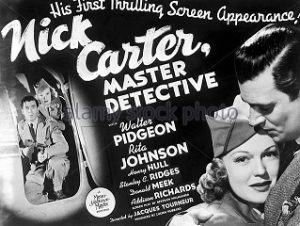
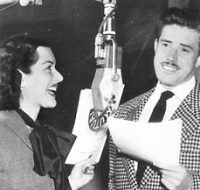 Nick Carter Magazine ran for 40 issues, from March 1933 to June 1936, the final six issues slightly retitled as Nick Carter Detective Magazine. While the magazine had folded, its long-running character still lived, for in 1939 Hollywood picked up the movie rights and produced three “B” Carter films starring noted actor Walter Pidgeon* (who later would star in the classic 1956 SF film Forbidden Planet). A mere three years later, Nick Carter would rise from the dead yet again in his own radio series, Nick Carter, Master Detective. The show’s producer and often the writer, Sherman “Jock” MacGregor, would enlist some of the best writers in the business to script Carter’s episodes, including Robert Arthur and David Kogan of Mysterious Traveler fame, the creator of The Shadow, Walter Gibson, and none other than legendary SF author Alfred Bester (one of which Bester-written episodes, “Chemical Chickens,” we ran in March of 2014 here). Lon Clark played Nick Carter throughout its 12-year run, ably supported by first Helen Choate until mid-1946 (photo above right with Lon Clark) and then Charlotte Manson as Nick’s intelligent, perky secretary Patsy Bowen. Other mainstay characters included Police Sergeant Matty Mathieson, young newspaper reporter Scubby Wilson, and scruffy old veteran of the crime game Waldo McGlynn.
Nick Carter Magazine ran for 40 issues, from March 1933 to June 1936, the final six issues slightly retitled as Nick Carter Detective Magazine. While the magazine had folded, its long-running character still lived, for in 1939 Hollywood picked up the movie rights and produced three “B” Carter films starring noted actor Walter Pidgeon* (who later would star in the classic 1956 SF film Forbidden Planet). A mere three years later, Nick Carter would rise from the dead yet again in his own radio series, Nick Carter, Master Detective. The show’s producer and often the writer, Sherman “Jock” MacGregor, would enlist some of the best writers in the business to script Carter’s episodes, including Robert Arthur and David Kogan of Mysterious Traveler fame, the creator of The Shadow, Walter Gibson, and none other than legendary SF author Alfred Bester (one of which Bester-written episodes, “Chemical Chickens,” we ran in March of 2014 here). Lon Clark played Nick Carter throughout its 12-year run, ably supported by first Helen Choate until mid-1946 (photo above right with Lon Clark) and then Charlotte Manson as Nick’s intelligent, perky secretary Patsy Bowen. Other mainstay characters included Police Sergeant Matty Mathieson, young newspaper reporter Scubby Wilson, and scruffy old veteran of the crime game Waldo McGlynn.
*(The first of the three Nick Carter films was 1939’s Nick Carter, Master Detective. Of interest to SF genre buffs is that it was directed by Jacques Tourneur, now famous for directing the following trio of Val Lewton horror films: Cat People (1943), I Walked with a Zombie (1943), and The Leopard Man (1943).)
From Nick Carter’s beginnings in 1886 through his final radio show in 1955, Carter would change with the times; from clean-living detective (actually, at the beginning of his career, Nick was a private investigator and consulting detective to the police department, much like Sherlock Holmes, and did not work as a police detective), master of disguise, to anti-espionage agent, to the bane of mad scientists or the defender of scientists beset by crooks, Nick Carter has enjoyed one of the longest surviving, most popular runs in various media for over 100 years, for when his radio show ended in 1955 he would resurface (yet again!) in a series of James Bond-type paperback novels in the 1960s which ran into the 1990s, quite a few of them written by women.
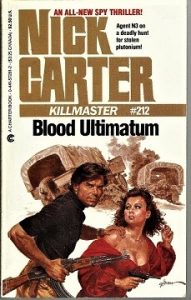
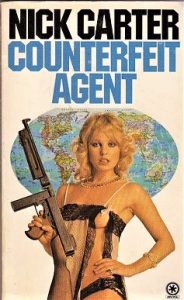
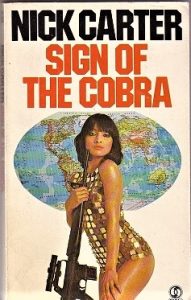
Virtually forgotten today, Nick Carter predates Sir Arthur Conan Doyle’s Sherlock Holmes, Dashiell Hammett’s Sam Spade, Raymond Chandler’s Philip Marlowe, and was originally inspired by the real-life exploits of private investigator Allan Pinkerton.
The premise and story line of “Nine Hours to Live” is a simple one. A convicted murderer has nine hours to live before he will be strapped into the electric chair and put to death. Not surprisingly he proclaims his innocence to one and all, and as a last request asks for the famous Nick Carter to do everything in his power to clear him. The only catch is that the prisoner has no real evidence to give Carter as a starting point to overturn his conviction. Thus, with no real exculpatory evidence and with a short deadline in which to achieve the impossible, Nick Carter nevertheless gives it his best shot. Without giving away too much, let’s just say that someone, or someone’s, are too clever by half and this convoluted little murder mystery may not end as you might expect, as Nick Carter, Master Detective pulls a rabbit out of his hat knowing that a convicted murderer has but “Nine Hours to Live.”
Play Time: 29:26
{Though this Nick Carter episode aired on a Tuesday evening in March of 1946 and the next day was a school day, the neighborhood gang made it to the local newsstand after school in plenty of time to look for more exciting detective fare. Mammoth Detective (1942-47) began with a huge page count but ran into a bit of trouble early and had to trim the magazine to something more (financially) manageable. Which it did for a decent five-year run, managing somehow to survive the paper shortage during WW II that ended many another pulp magazine. It switched from a bi-monthly to a monthly early in 1946 and managed 9 issues that year. Ten Detective Aces (1928-49) was one of the longer running detective pulps of its time, growing its audience carefully and managing to satisfy them for over 20 years, making it one of the most popular detective pulps of all time. It was a bi-monthly in 1946.Thrilling Detective (1931-53) was another long-lived survivor of the early detective pulp era and the paper shortage during world War II, consistently giving its stalwart readership something to look forward to. It was a monthly from 1931 until its first bi-monthly issue in November of 1945, then became a full-fledged bi-monthly publication in 1946.}
[Left: Mammoth Detective, Mar. 1946 – Center: Ten Detective Aces, Mar. 1946 – Right: Thrilling Detective, May 1946]
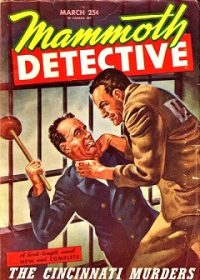
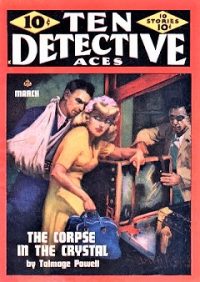
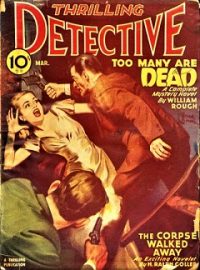
To view the entire list of weekly Old Time Radio episodes at Tangent Online, click here.